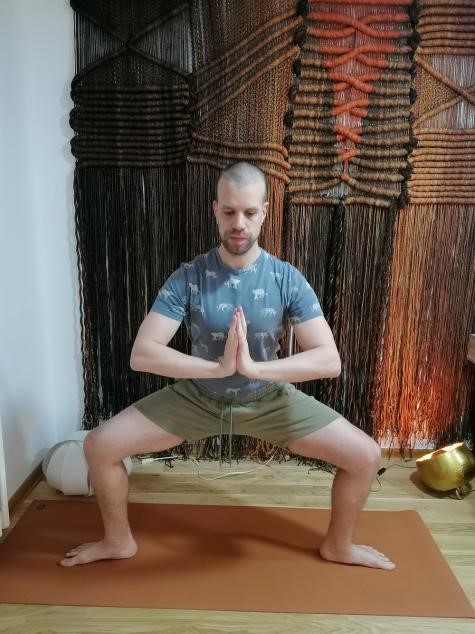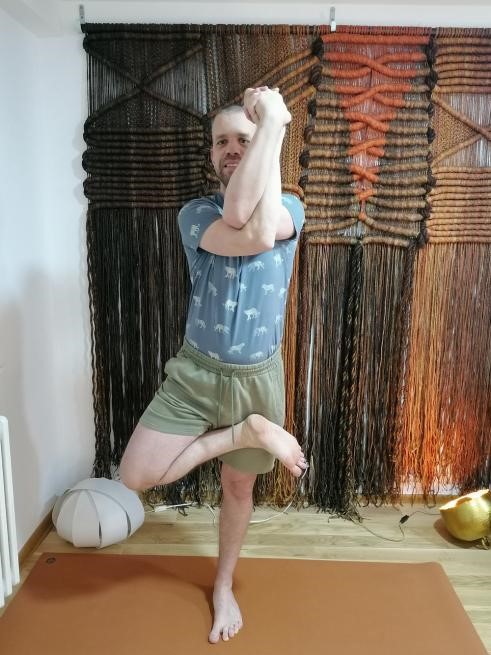Vatayasana consists of two words: Vataya, which means horse and Asana, which means pose. This is a pose of strength and flexibility, a pose that may seem easy to perform (if we look at its basic pose). But the challenge is to stay in this pose for a period of time.
A DEEPER INSIGHT
This asana is one of the upper-balance asanas. Considering the variations that can be practiced regarding this pose, it is safe to say that this pose falls into the category of beginner pose but also of intermediate poses.
By practicing this pose, the practitioner activates the sacral chakra. Keeping this fact in mind, this pose activates creative and sexual energy.
The sacral chakra itself represents an energy center that is essential for passion and pleasure.
The most demanding variations of this pose belong to the intermediate Ashtanga Vinyasa yoga series. These variations imply exceptional flexibility and openness of the hips. The basic pose and its variations are practiced within Hatha Yoga but also within the Iyengar Yoga system.
PRACTICE AND BENEFITS
The basic horse pose is entered from the mountain pose (Tadasana). From the mountain pose, a lunge is made with the right or left foot to the side. The toes of both feet are rotated ninety degrees. The basic pose means that the ankles are under the knees and the thighs are level with the floor. Arms are raised to shoulder height, palms down, or you can bring your palms together in front of your chest. In addition to being a pose of balance, it is also a pose of strength, given that the quadriceps are constantly active from the moment of entering the pose itself. In this basic pose, the gaze can be directed to the tip of the nose.

There are minor, non-demanding variations within this pose. The first involves lifting the heels off the floor in this exact pose. In this way, additional work is done to improve the sense of balance and the hands remain in the same position. A slightly more demanding variation implies that the heels are raised and that the arms are stretched above the head with the palms together. In both variations, the gaze is directed to the tip of the nose.
The third variation implies that the forearm of one hand rests on the same thigh while the other hand is stretched upwards, with a directed gaze towards the fingers of the outstretched hand. In this variation, in addition to the activation of the thighs, there is a fine rotation and stretching of the waist and hips of the raised arm.
The fourth variation implies that both palms are placed on the knees while the spinal column is twisted first to one side and then to the other. In this variation, there is a very intense rotation of the spinal column. The gaze is still directed at the tip of the nose, even though it is looking over the shoulder after the spinal twist has been performed.

The fifth and sixth variations are more demanding. The position of the arms for both variations is similar to that of the Eagle Pose. The fifth variation implies that the standing leg is fully active, which would mean that the toes of the foot are tightly “squeezing” the yoga mat itself, that the calf is tightened, that the kneecap is lifted upwards, and that the quadriceps is tightened the whole time. The gaze is directed at the tip of the nose or at one point about a meter, a meter and a half, from the body, if it is easier for the practitioner to establish focus, i.e., balance. The foot of the opposite leg descends on the thigh of the landing leg and the knee rotates with the cup down. The final part of this variation, which is essentially considered the entry position for the next variation, is the interlacing of the hands, whose position is the same as in the eagle pose. If the practitioner finds this interlacing difficult, the palms can be joined at the heart level. It is an easier variation when it comes to the position of the hands.
The sixth, most difficult and demanding variation of the horse’s pose implies that, beginning with the fifth variation, the knee of the leg with the foot on the thigh (half lotus position) is lowered to the yoga mat, while the standing leg is bent at the knee. That is, the thigh of the landing leg in the full pose is in line with the yoga mat. If it is currently impossible to get into a full pose while the hands are intertwined. The practitioner could try to work on the leg position and then try to work on the arm position. The gaze in this variation is at the tip of the nose or at a point in front of the body, as in the fifth variation.
The first four variations, as I mentioned at the beginning, are practiced mainly within Hatha and Iyengar yoga. The fifth and sixth variations are integral parts of Ashtanga Vinyasa yoga. Also, these two variations are very often practiced within vinyasa yoga.
The benefits of practicing this asana are manifold. The first thing that is achieved is the strengthening of your muscles, above all the muscles of the legs, and more precisely the muscles of the calves and thighs.
By practicing this pose, you establish better circulation and improve the flexibility of your muscles and reduce inflammation in the joints.
The asana itself has a great influence on establishing symmetry in the relationship between the legs and hips, of course, if the practitioner faces asymmetry in that part of the body.
We should certainly not forget the fact that by practicing this pose, better focus and concentration are achieved.
CONCLUSION
Considering the large number of variations of this asana, it gives you the opportunity to gradually progress in it. Consequently, there is no need to quickly switch from one variation to another.
Allow your body to feel open, stable, and strong in the variation you are practicing. That way, you will allow your body to progress at its own pace. Do not force the body but feel it.
If your hips are too closed, which would mean that you do not have the necessary mobility and therefore the flexibility of the hips, I advise you to practice yin yoga for the hips. Direct your full attention to the fine opening of the hips if you want to include the horse pose in your practice.
If you feel that you have no strength in your quadriceps, I advise you to practice the chair pose.
The pose itself is recommended for almost everyone, especially for skiers and runners. However, if you are pregnant or have an injured knee, sciatica, or disc herniation, feel free to skip this asana until further notice.
Namaste.







